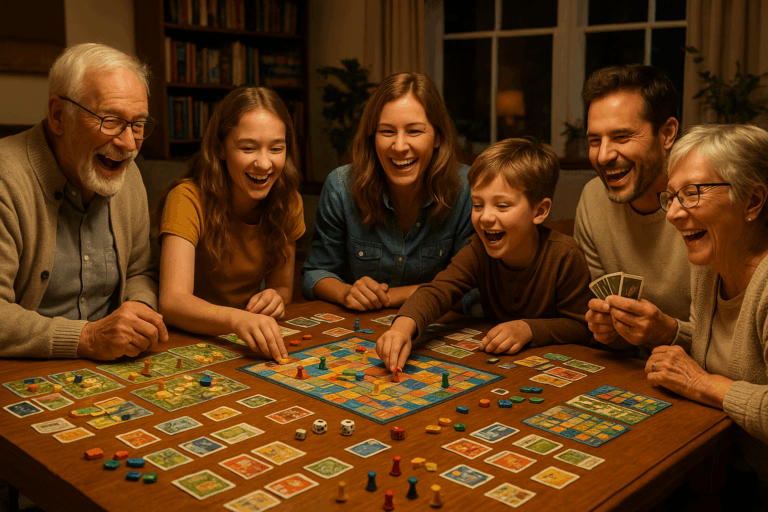You’re greeted with an array of colorful, tactile pieces, cards, dice, tokens, and sometimes even miniatures that promise hours of strategic enjoyment. 😃 But as your collection grows, so does the challenge of keeping it all organized and easily accessible. If your love for board games has begun to spill over into every corner of your house, don’t worry – you’re not alone, and this article is here to help.
In this comprehensive guide, we’ll delve into the world of board game organization and storage, exploring a range of solutions that cater to collections of all sizes and types. From simple sorting strategies to specialized storage furniture, this article will provide you with everything you need to keep your board game collection in top shape.
What makes board game organization so important, you might ask? Besides the obvious benefit of tidying up your living space, a well-organized game collection can make it easier to find and enjoy the games you love. When each game has its place, you’ll spend less time hunting for missing pieces and more time actually playing. Plus, taking care of your games can prolong their lifespan, protecting your investment and ensuring that your favorite games will be around for many more game nights to come. 😎
But organizing a board game collection isn’t just about practicality – it’s also an opportunity to showcase your passion. With the right storage solutions, your games can become a part of your home’s décor, a conversation piece that reflects your personal taste and hobby. From sleek shelves that display your games like works of art, to custom-built cabinets that hide them away for a minimalist look, there’s a storage solution out there that’s perfect for you.
Over the course of this article, we’ll cover a number of key topics that every board game collector needs to consider. These include:
Sorting Strategies
Before you can start organizing, you need to decide how you’ll sort your games. We’ll discuss a variety of sorting methods, from the simple (alphabetical, by size, by type) to the more complex (by player count, by gameplay duration, by complexity level).
Storage Solutions
From DIY to off-the-shelf, we’ll explore a range of storage solutions for your board games. Whether you’re looking for inexpensive ways to repurpose furniture you already have, or you’re ready to invest in specialty storage designed specifically for board games, we’ll provide you with plenty of options to consider.
Preservation Techniques
Board games can be delicate, and improper storage can lead to damaged pieces or worn-out cards. We’ll share some tips and tricks for preserving your games in pristine condition, so you can continue to enjoy them for years to come.
Game Room Design
If you’re lucky enough to have a dedicated game room, we’ll offer some design ideas to make the most of your space. From optimizing table layout for gameplay, to lighting and décor that sets the perfect gaming atmosphere – we’ll cover it all.
So, whether you’re drowning in a sea of game boxes, or you’re just starting to build your collection, this guide is sure to offer some helpful advice. Get ready to take your board game hobby to the next level – let’s dive in! 🎲
🎲 Unleashing the Board Game Beast: Understanding the Need for Organization and Storage
Whether you are a casual player or a dedicated board game enthusiast, you can’t ignore the importance of proper organization and storage. With the increasing popularity of board games, many households now have a sizeable collection, and managing this collection can become a real challenge. While playing is a lot of fun, sorting out the clutter afterwards can be a chore. That’s where the importance of board game organization and storage comes in.
The key to a well-organized board game collection is not just about keeping things neat and tidy. It’s also about prolonging the life of your games, ensuring all pieces are accounted for, and enhancing your gaming experience by reducing setup and pack up time. Plus, a well-organized collection looks great and can even serve as a conversation starter when guests come over.
But the question that looms large is how? How can one best organize and store a diverse collection of board games? Don’t fret! We’ve got you covered. In this guide, we will walk you through some of the best strategies and solutions for board game organization and storage. So, sit back, relax, and keep reading.
🔍 The Lay of the Land: Understanding Different Board Game Sizes and Types
Board games come in all shapes and sizes. From pocket-sized travel games to expansive tabletop role-playing games, there is a wide range of variety when it comes to physical dimensions. Understanding the different sizes and types of board games is a crucial first step in your organization and storage journey. It will help you to choose the right storage solutions and devise a system that works best for you.
Essentially, board games can be categorized into three main sizes: small box games, medium box games, and large box games. Small box games are compact and usually lightweight, making them great for travel or small spaces. Medium box games are a bit larger and heavier, usually featuring more components and a more complex gameplay. Large box games are the behemoths of the board game world, often packed with hundreds of pieces and requiring a significant amount of space to play.
Furthermore, games can also be divided into different types, such as card games, strategy games, party games, etc. Each type may have unique storage needs based on the number of pieces, board size, and other factors. For instance, card games may require specific card holders, while large strategy games may benefit from custom storage solutions.
📋 Game On: The Ultimate Board Game Organization and Storage Solutions
Once you understand the sizes and types of your games, it’s time to explore the various organization and storage solutions available. Remember, the goal is to find a system that is practical, scalable, and pleasing to the eye. Let’s dive in.
1. Shelf Solutions: Making the Most of Your Space
Shelves are the backbone of any board game storage solution. They are versatile, easy to install, and can accommodate a wide range of game sizes. You can opt for standard bookshelves, floating shelves, cube shelves, or even custom-built gaming shelves depending on your space and budget. The key is to choose a shelving solution that fits your room decor and provides enough space for your games.
2. Box Organization: Keep Your Components in Check
Inside each board game box are numerous pieces that can easily get lost or mixed up. Box organizers are a great way to keep your game components orderly and easy to find. They come in various types, from simple baggies and plastic containers to custom inserts and foam core organizers. Choose an option that suits your budget and level of organization required.
3. Vertical Stacking: The Sky’s the Limit
Vertical stacking is a popular storage method among board game enthusiasts. It allows you to store more games in less space and makes it easier to retrieve a game without disturbing the others. However, keep in mind that not all games are suitable for vertical storage. Check the box structure and component arrangement before opting for this method.
🧮 Comparison of Board Game Organization and Storage Solutions
To give you a clearer picture, let’s compare some popular board game organization and storage solutions in the following table.
Storage Solution
Pros
Cons
Shelves
Versatile, easy to install, scalable
May require more space, not mobile
Box Organizers
Keeps game components orderly, enhances gameplay experience
Can be costly for large collections, may not fit all game boxes
Vertical Stacking
Space-efficient, easy access to games
Not suitable for all games, risk of box damage
For a visual guide on board game organization, check out the video “Board Game Organization 101” by Gaming Rules! on YouTube. It offers practical tips and showcases different organization methods in action.
🔖 Remember, It’s Your Game!
At the end of the day, it’s your board game collection, and you should organize and store it in a way that suits you the best. Experiment with different solutions, adjust as your collection grows, and don’t forget to have fun in the process. Because after all, that’s what board games are all about. So, game on and happy organizing!
ConclusionIn conclusion, the complex yet fascinating world of IT and engineering has been broken down into bite-sized pieces, in the hopes of shedding light on some of the most intricate concepts and practices in the industry.
From the initial understanding of the basics of software engineering principles, to the deeper exploration of the methodologies and best practices of the industry, we’ve gone a long journey. I believe, now, you are in a better place to appreciate the underlying mechanics of the sector and the high level of expertise it requires to maintain its growth trajectory.
The importance of understanding these concepts cannot be overstated. In an ever-evolving digital landscape, a solid understanding of software engineering principles, methodologies, and best practices can provide the necessary foundation for successful project execution.
For instance, the discussion on software development life cycle (SDLC) models offered a comprehensive insight into how software is conceived, developed, and maintained. The importance of following a structured approach in software development was emphasized, as it ensures a higher quality of software and more efficient utilization of resources.
The deep dive into different methodologies like Agile, DevOps, and Waterfall revealed the pros and cons of each, providing a clearer perspective on when to apply each one. While Agile promotes flexibility and customer satisfaction, DevOps focuses on continuous delivery and cross-functional collaboration, and Waterfall offers a sequential and easy-to-understand approach.
Further, the discussion on best practices like coding standards, code reviews, and testing showed the immense value these add in creating a robust, error-free, and efficient software. In this digital era where software rules everything, adhering to these best practices can be the difference between success and failure.
It’s crucial to remember that software engineering is a dynamic field, continuously evolving and improving. Keeping abreast of the latest developments and being open to learning new concepts and technologies is the key to staying relevant.
I hope this article provided a comprehensive and clear understanding of the complex world of software engineering. I encourage you to continue exploring, learning, and applying what you’ve learned in your work and projects. Share this article with your colleagues, or leave a comment below to discuss further. You can always refer back to this piece as your guide, or check out these credible sources for more information: source 1, source 2, source 3.
Thanks for investing your time to read this article. Keep learning, keep growing! 🚀👩💻
Tags: #SoftwareEngineering, #BestPractices, #Methodologies, #SDLC



